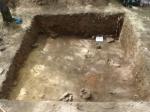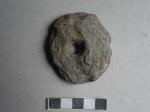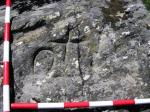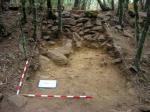Summary (English)
Research (2007-2008)
Located at an altitude of 1073 m, between Sanabria and La Carballeda, two districts in the province of Zamora, the archeological site of Peñas de la Cerca has a complex defensive system. It comprises an elevated area, where the main wall of the hill-fort is situated, and a wide network of terraces, which descend towards the valley, with a total area of 2 ha.
The main settlement, situated on the highest point of the area, is where the largest amount of archaeological material has been found on surface. In this sector there is a series of non-natural terraces, reinforced with retaining walls, whose purpose remains controversial.
The 2007 and 2008 excavations, conducted by Óscar Rodríguez and José Carlos Sastre Blanco, focused on the area of the wall and revealed a defensive structure made up of slate blocks with no mortar. Excavation work was also carried out in the housing area. A large dwelling structure with an oval floor plan, encompassing a number of post holes was found there. This chamber had several hearths and a seed tank.
Among the archeological material unearthed during those years, it is especially important to highlight the presence of a remarkable lithic industry, boat-shaped mortars, slingshot projectiles and a small flint arrowhead being the most outstanding pieces.
Most important among the rest of archeological material is the high amount of First Iron Age handmade pottery, with a micaceous paste and reduction firing, and presenting mainly fingernail and digital decoration. As regards metallic materials, a bronze simple spring fibula was recovered. The fibula has a highly arched bow and it is extremely well preserved.
(translation by Laura González Fernández)
- José Carlos Sastre Blanco
Director
- José Carlos Sastre Blanco (Universidad de Granada; Asociación Científico-cultural Zamoraprotohistórica)
- Óscar Rodríguez Monterrubio (UNED; Asociación Científico -cultural Zamoraprotohistórica)
Team
- David Sánchez; Cristina Mateos; Gustavo González; Álvaro Mata; Raquel Portilla; Carlos Merino
- Alicia Barrigón
- Inés Muñoz
- Ana Ramírez; Noemí Delgado; Alberto Martín; Rebeca Alonso; Juliana Martínez; Anita Pinagli; Jaime de la Vega; Eva González; Enrique Paniagua; Marta Martínez; Sagrario García; María José Muñoz; Virginia Cubas; Sophie Hill; Adrienne Frie; Ana Uzal; Fiodora López; Patricia Blanco
Research Body
- Universidad de Granada
Funding Body
- Asociación Científico-cultural Zamoraprotohistórica
- Caja Rural de Zamora






![Download [PDF]](/excavation/skins/fasti/images/results/download_sml.png)



